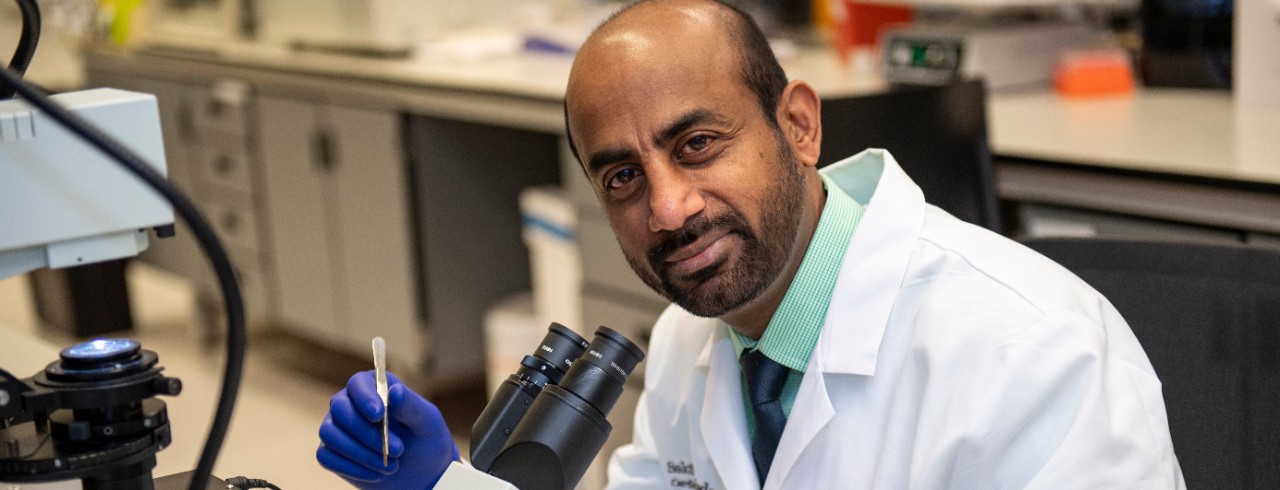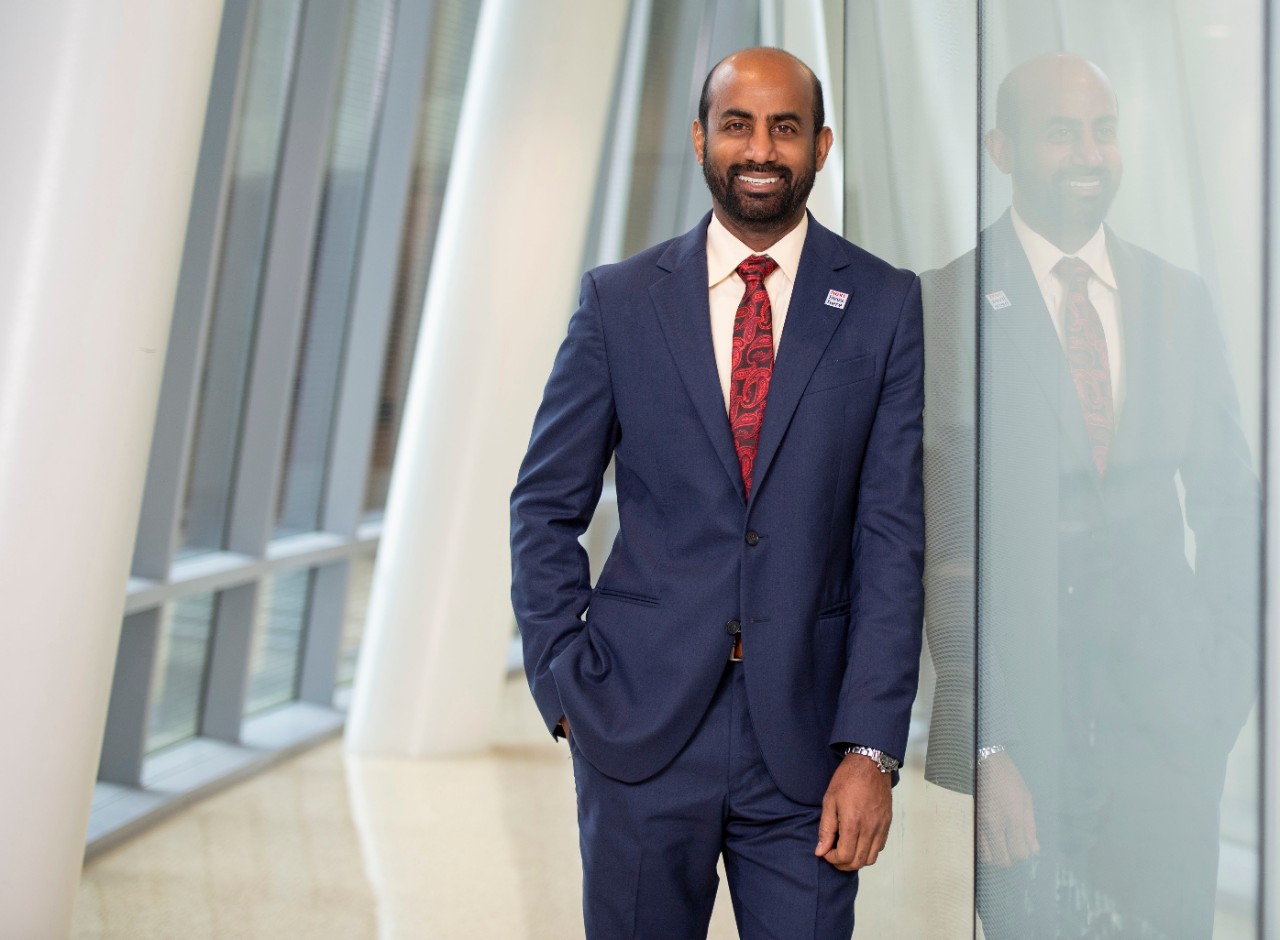
Sadayappan named executive director of the Center for Cardiovascular Research
New center will enhance team science and collaboration among UC cardiovascular researchers
Sakthivel Sadayappan, PhD, MBA, has been appointed executive director of the new University of Cincinnati College of Medicine Center for Cardiovascular Research (CCR).
“Dr. Sadayappan has established himself as an internationally respected cardiovascular researcher and has built a remarkably vibrant and successful laboratory since joining the faculty in 2016,” says Andrew T. Filak Jr., MD, senior vice president for health affairs and Christian R. Holmes Professor and Dean of the UC College of Medicine. “I am very pleased to appoint him to this new position and will enthusiastically watch as he brings together and grows a strong team of cardiovascular scientists to promote transformational and pioneering research that results in rapid advancement in the understanding, prevention and treatment of cardiovascular disease.”
Sadayappan currently holds the Dr. James F. Heady Chair in Medicine in the Department of Internal Medicine, Division of Cardiovascular Health and Disease. He has served since 2019 as vice chair for basic research in the department and is associate chief of basic research in the Division of Cardiovascular Health and Disease.
“I am really excited for this opportunity. The purpose of my journey is to build advanced cardiac research and my dream is now starting,” Sadayappan says.

Sakthivel Sadayappan, MD, MBA (Photo/Colleen Kelley/UC Marketing + Brand)
Sadayappan notes that College of Medicine faculty currently hold 38 grants from the National Heart, Lung and Blood Institute to conduct various aspects of cardiovascular research. He sees that number quickly growing, in addition to increasing the number of federal training grants for young investigators. The College of Medicine currently holds two National Institutes of Health (NIH) cardiovascular training grants.
“Historically, the College of Medicine is known as a hub for cardiovascular research. I originally came to Cincinnati Children’s in 2002 as a postdoc because this is the place for cardiovascular research. Between UC and Cincinnati Children’s, we have significant NIH funding and excellent clinical research programs,” Sadayappan says. “My purpose is to connect all cardiovascular research activities at UC under one umbrella. We will focus on team science. My job will be to connect all of the researchers and go for big ideas and better outcomes. The focus will be for larger grants so that we can really build a strong program.”
The CCR’s primary objective is the development of groundbreaking collaborative research programs for complex cardiovascular diseases by systematic integration of basic and translational studies, along with training across disciplines, departments and other institutions, both national and international. The CCR will integrate research programs that focus on basic and translational research to advance bench-to-bedside patient care and personalized medicine and emphasize interdisciplinary studies within a collaborative framework. Through broadly tailored research programs, Sadayappan will organize, coordinate and unify cardiovascular experts toward advancing the Center’s mission.
The CCR will work closely with College of Medicine faculty members, as well as institutes and centers, such as the UC Gardner Neuroscience Institute, University of Cincinnati Cancer Center, Cincinnati Children’s Heart Institute, and members of the Cincinnati Chapter of the American Heart Association. Additionally, the CCR may expand its collaboration with local hospitals to support the UC Heart Bank and clinical studies.
Sadayappan expects the CCR to initially have at least 35 faculty as members. While most center members will be faculty from the College of Medicine, including at Cincinnati Children’s, others will be UC faculty from the James L. Winkle College of Pharmacy, the Biomedical Engineering Program at the College of Engineering and Applied Science and the Department of Biological Sciences at the College of Arts and Sciences, in addition to other UC colleges.
Sadayappan says he plans to build upon four primary areas of cardiovascular research strength at UC: myocardial infarction, cardiac fibrosis, cardiac inflammation and genetic heart disease. Additionally, he expects to broadly incorporate artificial intelligence into the program to expand drug discovery and treatment options and to better understand molecular mechanisms.
Sadayappan, who had led the heart branch of the former UC Heart, Lung and Vascular Institute (UCHLVI), adds that the CCR will be focused exclusively on cardiovascular research unlike the UCHLVI, which had a broader emphasis that included pulmonary systems and vascular disease.
An internationally respected investigator, Sadayappan’s research focuses on muscle biology emphasizing the underlying physiological and pathophysiological pathways in cardiovascular health and disease. He has built his research program around the goal of improving health outcomes and preventing muscle disease. His research team is currently using small molecules and gene therapies to treat hypertrophic cardiomyopathy, skeletal myopathies, smooth muscle myopathy, inflammation and distal arthrogryposis in cardiovascular, cancer toxicity and neuro-junctional diseases. In addition to his basic research, he also conducts collaborative, population-based clinical studies related to genome-phenome analysis in the South Asian community within the United States.
Currently, Sadayappan serves as a committee member for the American Heart Association (AHA) Basic Cardiovascular Sciences Executive Council, International Society for Heart Research and the AHA Scientific Session Organizational Committee. He is president of the Cardiac Muscle Society and Society for South Asian Heart Research and. serves as a board member of the local Cincinnati branch of the AHA.
Sadayappan received his doctorate in biochemistry from Madurai Kamaraj University in Madurai, India. He was a postdoctoral research fellow at the Max-Planck Institute in Germany and then a postdoctoral fellow, research associate and research instructor at Cincinnati Children’s. Before joining the UC College of Medicine faculty, he was an associate professor and director of the Heart Failure Program, Cardiovascular Research Institute at Loyola University in Chicago.
Lead photo/Colleen Kelley/UC Marketing + Brand
Related Stories
Camp aims to empower children, teens who stutter
July 17, 2024
A one-week, evidence-based program for children and teens who stutter at the University of Cincinnati will teach kids to communicate effectively, advocate for themselves and develop confidence about their communication abilities. Camp Dream. Speak. Live., which is coming to Cincinnati for the first time July 22-26, began in 2014 at the University of Texas at Austin. The Arthur M. Blank Center for Stuttering Education and Research at UT expects to serve more than 2,000 children at camps across the United States, Africa, Asia and Europe this year.
UC archivist explores Troy’s invisible workers
July 17, 2024
UC Classics archivist Jeff Kramer examined the unheralded and largely uncredited role laborers played in the 1930s excavation at Troy in Turkey.
U.S. stroke survival is improving, but race still plays role
July 16, 2024
U.S. News & World Report, HealthDay and Real Health covered new research from the University of Cincinnati that found overall rates of long-term survival following stroke are improving, but Black individuals experience worse long-term outcomes compared to white individuals.
Presidential challenge to UC: Join Ride Cincinnati to fight cancer
July 16, 2024
UC President Neville Pinto has again challenged every UC college and unit to send at least one rider to the September 14 Ride Cincinnati event to help fundraise for cancer research and cancer care. UC students ride free. Signup by July 31 for free UC-branded cycling jersey.
Pediatric ICU rates linked to housing quality, income, education
July 16, 2024
Healio highlighted research led by the University of Cincinnati and Cincinnati Children's Hospital's Carlie Myers that found a link between pediatric ICU admission rates and housing quality, household income and education.
UC study: Long-term stroke survival improving, but racial disparities remain
July 15, 2024
New research from the University of Cincinnati published in the journal Neurology found long-term survival rates following acute ischemic strokes are improving, but Black individuals experience worse long-term outcomes compared to white individuals.
Students organize to shake up Parkinson's care model
July 15, 2024
University of Cincinnati student and Parkinson's Together founder Mallika Desai joined the Parkinson's Experience Podcast to discuss the nonprofit's origins and multidisciplinary mission to meet the needs of patients in their community.
Mobile app could help people manage fibromyalgia, UC study suggests
July 15, 2024
WVXU highlighted research led by the University of Cincinnati's Lesley Arnold and Swing Therapeutics that found a self-guided smartphone-based behavioral therapy led to significant improvements for patients with fibromyalgia.
UC study finds better cardiovascular health outcomes with home hemodialysis
July 15, 2024
Dialysis patients using a more traditional home hemodialysis procedure have lower incidence of cardiovascular disease than patients using a less invasive peritoneal dialysis at home, a University of Cincinnati researcher finds.
Heat waves in the U.S. kill more people in their homes than anywhere else
July 12, 2024
Tasha Turner-Bicknell, an associate professor in the UC College of Nursing, spoke with the Cincinnati Enquirer for a story about heat-related deaths. Many people are dying within their homes during periods of excessive heat and lack of air conditioning is a factor.
